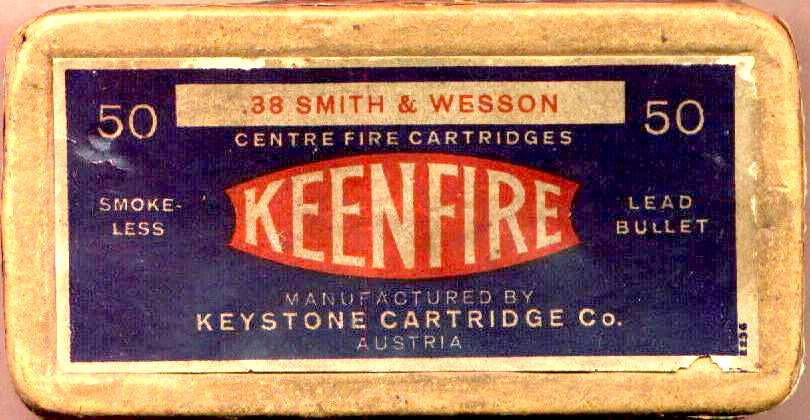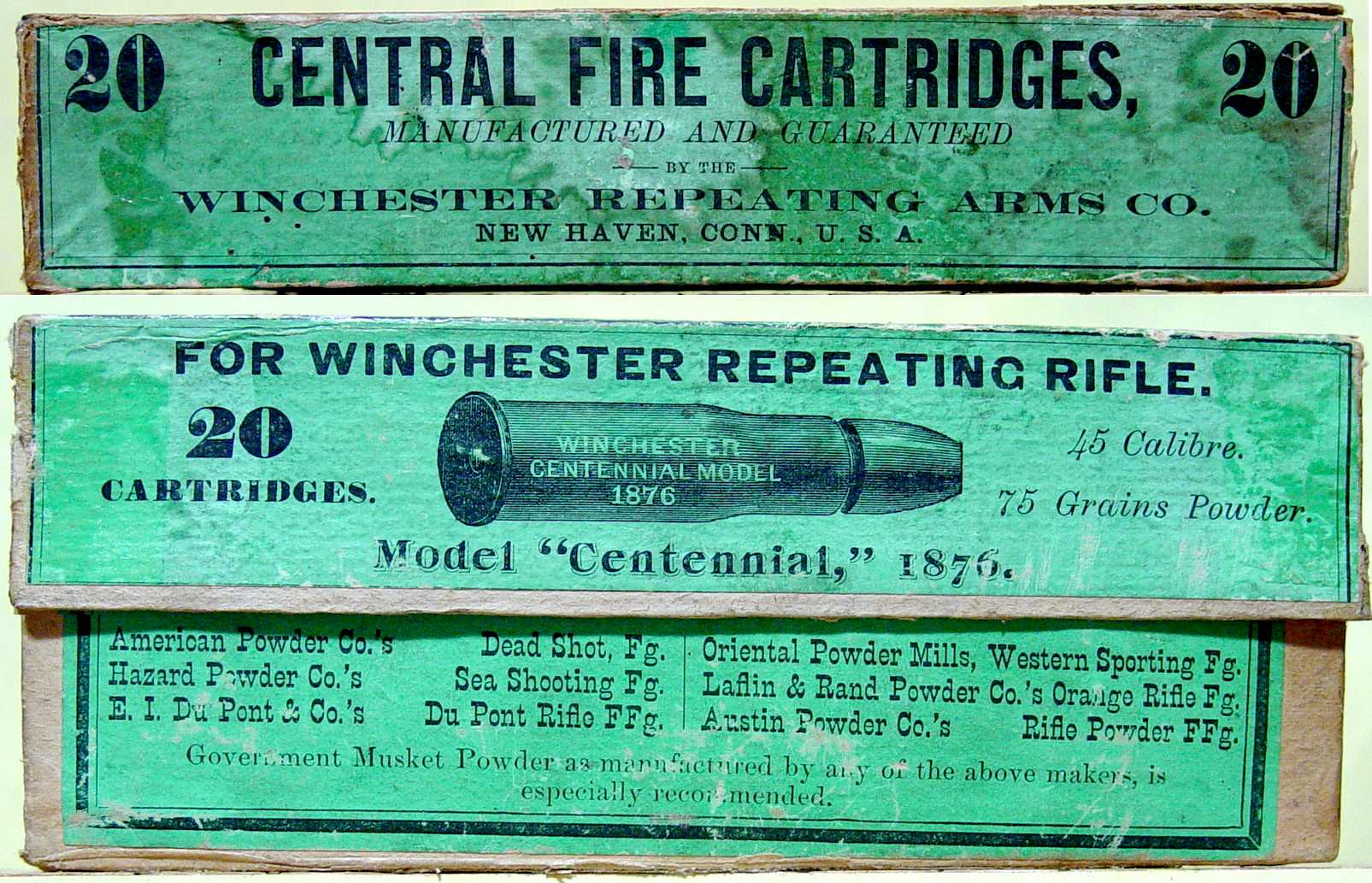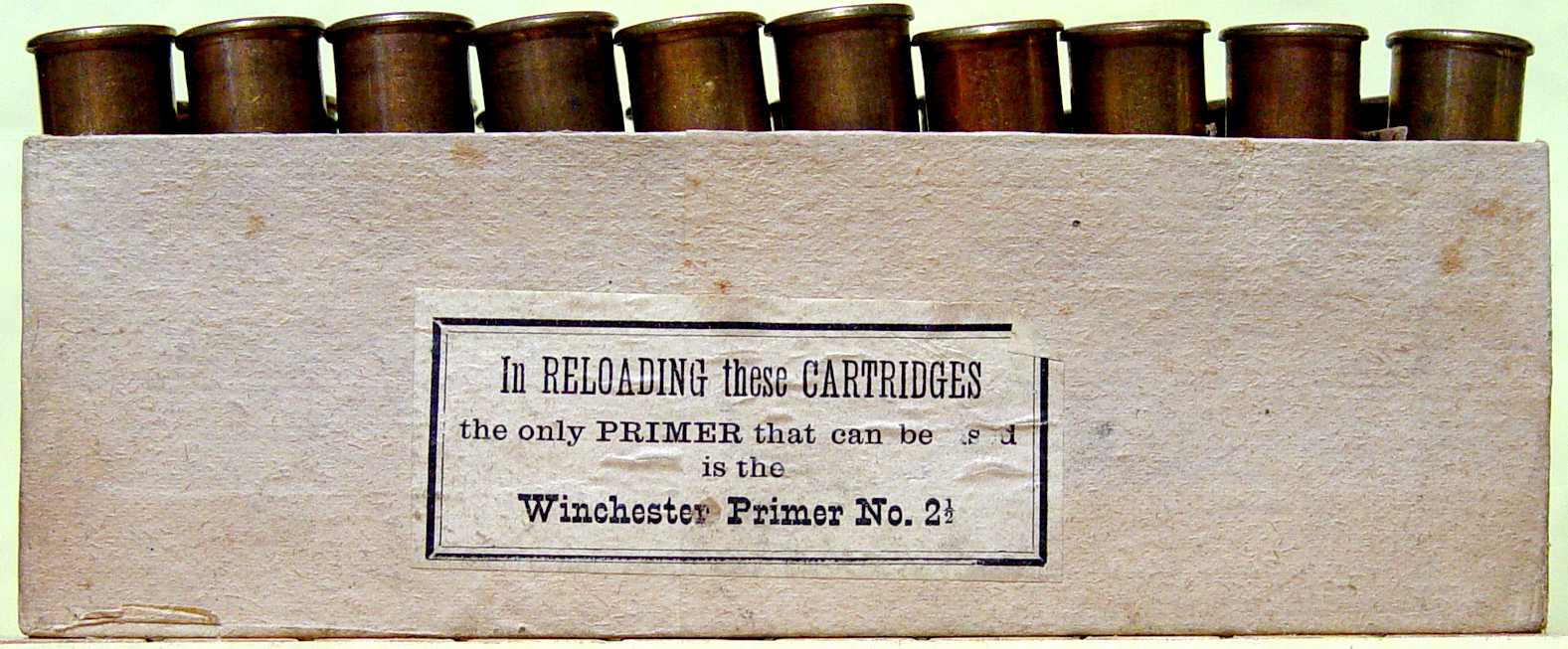|
THE CARTRIDGE COLLECTOR'S EXCHANGE |
| Contents
Cartridge
Lists
Prior Picture Pages:
Links to Other Sites
Cartridge Collectors Organizations:
Auctions:
Books:
Other Collector's Sites: |
Home of the Old Ammo Guy's Virtual
Cartridge Trading Table
Picture Page January 2011 A trio of Keystone Cartridge Company boxes......
My first Keystone box was the one shown above in .38 S&W. It is empty, so I
was
I posted a picture of the headstamp on the International Ammunition
Association's Cartridge Forum, and soon learned that the 'AG' stands for
aktiengesellschaft, a term
The box is shown to the right. As on the .32 ACP box, the banner on this label is blue with yellow lettering, but this one is marked KEENFIRE. The side label indicates that the cartridges were made to fit all 38 caliber center fire revolvers. This is probably correct; with the base and neck measuring .378" and the rim .428", the cartridges should be a good fit for most of the .38 revolver cartridges that were in use in the early 1900s except possibly the .38 S&W and the .38 New Police, for which they would be slightly loose but still serviceable since the low pressure resulting when these blanks are fired should not cause any serious issues.
.
A close look at some early Winchester .45-75 boxes... In 1876, the Winchester Repeating Arms Company introduced their Model 1876 rifle at the Philadelphia Centennial Exposition, where it was honored as the 'Best Magazine Rifle For Sporting Purposes Yet Produced'. This rifle was a beefed up version of the popular Winchester Model 1873 rifle action, with a longer cartridge lifting mechanism that allowed the company to develop more powerful cartridges than the .44-40, their most potent center fire offering at the time. The company had hoped to produce a repeating rifle that could handle the .45-70 Government cartridge with its 405 and 500 grain bullets, but in adapting the Model 1873 action for more powerful ammunition, it became apparent that the toggle-link action had its limitations and would not be suitable to handle even the 405 grain Government load. When introduced, the Model 1876 rifle was chambered for only one cartridge, the .45-75 Winchester center fire (WCF). Other cartridges soon followed: .45-90 in 1878 (loaded with a 350 grain bullet and soon discontinued), .45-60 and .50-95 Express in 1879, and .40-60 in 1884. The Model 1876 was essentially rendered obsolete with the introduction by Winchester of their Model 1886 rifle (chambered for the .45-70 Government cartridge, of course) with its improved, stronger action. By 1888, with serial numbers in the 63500 range, production of the Model 1876 stopped for three years, after which only 326 were produced, probably from parts on hand, the last one assembled in 1898.
Production of the .45-75 Winchester center fire cartridge began in 1876, yet it did not appear in the Winchester catalog until 1878. These boxes are labeled for the Winchester Repeating Rifle, Model "Centennial' 1876, in reference to the introduction of the rifle during the celebration of the 100th anniversary of the formation of the United States. I recently purchased two boxes of .45-75 cartridges that were made by Winchester, one of which is a very early box and is pictured here. The grooved bullet on the unheadstamped cartridge illustrated on the front label and the 6 brands of powder that are listed on
the reloading label are characteristics of the first boxes produced in 1876.
This reloading label continued in use unchanged until about 1882, after
which it included just three brands of powder. The
styles of the '20's on the labels of this box are not as fancy as the earliest
ones used, indicating that it could not have been produced as early as
The production period for this box can be determined to have fallen within
about a two year period based not on its characteristics already discussed, but on those of
the small tan label found on the back, which states that 'IN RELOADING THESE
CARTRIDGES the only PRIMER that can
be used is the Winchester Primer No. 2 1/2'.
The number 2 1/2 primer was introduced by Winchester in 1879, so the box
could not have been made earlier than 1879. In addition, this label makes no
mention the Anson Mills cartridge belt, which Winchester became the sole
distributor of in 1880. After this date, the company added two lines to
This second box of .45-75 WCF cartridges is a later box. The reloading label on this box is a narrower style, and lists only 3 brands of powder; it also includes the instructions to use only
Winchester primer No 2 1/2, so there was no longer a need to add the separate tan label. This narrow reloading label was first used around 1886. In addition to having an ungrooved bullet, the illustrated cartridge on the front label has the W.R.A.Co. 45-75
W.C.F. headstamp that is on the cartridges in the box, indicating production after about 1888 or 1889.
This last box I've had for quite some time; it is a blue label variation, made a little earlier than the second box discussed above, probably around 1886 based on the lack of a headstamp on the cartridge illustrated on the front label and its narrow reloading label. There are at least two box variations between this box and the first box discussed above, one with the grease groove on the bullet of the illustrated cartridge and the wide green reloading
label with three brands of powder listed, and the other without the grease groove and with the wide green reloading label. While the illustrated cartridge on this third box has no headstamp, the cartridges in the box are headstamped. It often took several years for the labels to reflect changes, due to the costs associated with creating new ones. The headstamp on these cartridges differs slightly from those in the box above, the letters being taller and slightly narrower than on those in the later box.
I depended rather heavily on Ray Giles and Dan Shuey's One Hundred Years of Winchester Cartridge Boxes 1856 - 1956 for the information presented in this article. This is a wonderful book which has information on hundreds of Winchester boxes, all photographed in color. It adds another dimension to searching for and accumulating these beautiful old boxes, allowing you to determine about when a specific box was made and whether or not it is a rare one. I highly recommend this book to anyone with an interest in old ammunition and its packaging. . . .
|

 Over
the years I have encountered three variations of Keystone Cartridge Company
boxes, and have an example of each in my collection; I have included
pictures of them here. I don't think they are particularly rare, nor do they
demand much attention when they occasionally show up on the internet
auctions sites. I didn't pay more than $10 for any of the three.
Over
the years I have encountered three variations of Keystone Cartridge Company
boxes, and have an example of each in my collection; I have included
pictures of them here. I don't think they are particularly rare, nor do they
demand much attention when they occasionally show up on the internet
auctions sites. I didn't pay more than $10 for any of the three.
 the bottom of this label which stated 'For convenience in carrying, use ANSON
MILLS' WOVEN CARTRIDGE BELT.' Therefore, it is safe to say that this
box was made between 1879 and 1880.
the bottom of this label which stated 'For convenience in carrying, use ANSON
MILLS' WOVEN CARTRIDGE BELT.' Therefore, it is safe to say that this
box was made between 1879 and 1880.